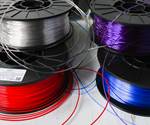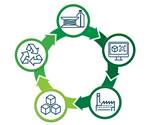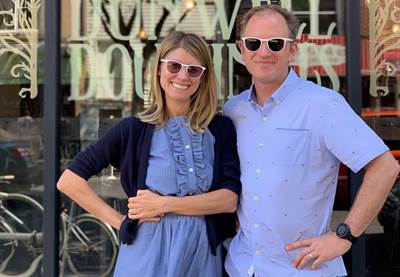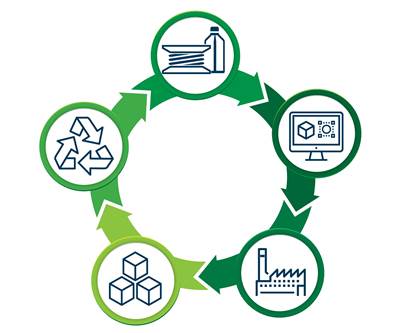Parametric Design and 3D Printing Deliver Custom, Sustainably Manufactured Furniture
Model No. operates at the intersection of technology and design. Its custom furniture is made on demand through a combination of proprietary large-format 3D printers, sustainable materials and a sleek online storefront.
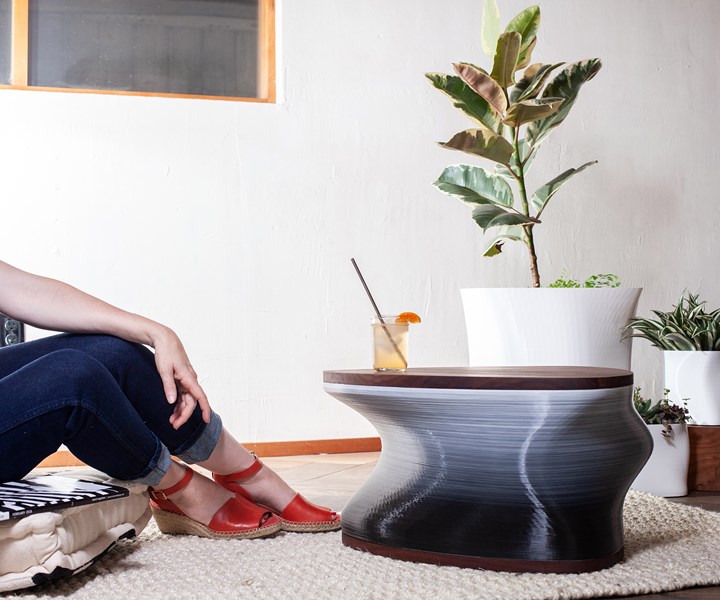
What’s in a model number? At furniture startup Model No., which manufactures each piece to order, the model number literally describes the color, shape and size of every table, chaise, planter and more. Photos: Model No.
Historically, a model number has been a label to describe a line of mass-produced products. “Ford Model T” instantly brings to mind one type of vehicle while “Tesla Model S” calls up another.
But what happens in an era of infinite customizability, when 3D printing and parametric design combine to allow consumers to create their own unique products? Suddenly a model number’s focus narrows. Instead of a whole product line, it might describe just one individual piece. And at furniture manufacturer Model No., it does exactly that. The Oakland, California, company builds custom tables, vases and more from milled sustainable hardwood and bio-based PLA that can be 3D printed to the geometric and dimensional specifications set by the consumer through its online storefront.
“Every product ordered gets its own model number that actually represents its custom configuration,” says Jeffrey McGrew, one of Model No.’s three cofounders. “That number becomes part of the URL for the product. If you email that URL to somebody else, they’ll wind up in the configurator with that product in the color, shape and size you customized.”
But the promise is more than an elegant way of sharing ecommerce pages; what Model No. offers is the ability to customize a piece of furniture for both the space and its user, to preview it in real time, and to have that piece manufactured affordably and on demand from sustainable materials. As the company’s name hints, delivering on this promise points to a future where a model number ceases to be a broad general label, and becomes something closer to a fingerprint.
Affordable Custom Furniture, with a Shorter Lead Time
McGrew and his cofounder Jillian Northrup are perhaps more aware than most of the problems with custom furniture. The pair frequently ran into challenges sourcing custom pieces at the company they founded before Model No., a boutique design-build firm called Because We Can. They met the third Model No. cofounder, Vani Kholsa, while working with her on a residential construction project through BWC.
“Vani had some hurdles in finding furniture pieces for her house that were the right size,” Northrup recalls. “The reality around the custom-made furniture industry is that it is very expensive to make a custom piece, it takes a long time to get it, and the offerings are still fairly limited.”

Jeffrey McGrew, Jillian Northrup and Vani Kholsa cofounded Model No. after difficulties in sourcing custom furniture for a residential construction project.
In talking out how to source custom furniture on an accelerated timeline, the three realized that a combination of parametric design and computer-driven manufacturing could change the status quo. Northrup and McGrew had experience using digital fabrication technologies including 3D printing and CNC machining for the architecture business, while Kholsa brought the software expertise needed to make tailored, on-demand furniture a reality.
Model No. was born in 2018, and launched its website in July 2019 with a line of tables and storage bins featuring machined hardwood tops and 3D printed PLA bases. Today the offerings also include vases, planters and chaise lounges; additional seating and a line of outdoor furniture are coming soon.
Each piece is customizable, from the type of wood and shape of a tabletop down to the color and size of its 3D printed base. Even the geometry of a table base can be manipulated using sets of sliders to adjust its “twist” and dimensions. With the options available, customers can create a piece of furniture that precisely fits their bodies, their spaces and their sense of taste.

All three of these tables began as Model No.’s 117 side table, but each has been customized into a different size, shape and color combination.
Once a furniture order is placed, the fabrication files for the wood and PLA parts are slotted into a semi-automated queue to be conveyed to a CNC router and 3D printer respectively. “The first time a human actually touches the order after you place it is when the operator presses ‘go,’” Northrup says.
Printing can typically be completed within 1-2 days, and then both the plastic and wood are hand finished and assembled together. Model No. promises a lead time of just 3 weeks from order to delivery, with prices in the hundreds, rather than thousands, of dollars.
Product Development and Manufacturing Via Parametric Design
From the customer’s perspective, the ordering process seems streamlined and effortless. The options are intuitive and easy to adjust, and the effect is illustrated in real time with a rendering generated each time a modification is made. Even the pricing adapts as the design changes. When the furniture arrives, it will appear exactly as designed. But despite the sleekness of the model maker and ease of ordering, there is much more happening beneath the surface to enable this streamlined buying experience.
Model No.’s ability to manufacture anything a customer can input is made possible by parametric design, a design strategy that uses algorithms and rules to modify a geometry. In Model No.’s case, this strategy is enabled by Grasshopper, a parametric design platform for the Rhino CAD package. Model No. uses a variety of other tools and customizations written on top of this software to link the online customer design experience to the final printable file. Maintaining this connection also means thinking about product development differently.
“When we develop a new product, really what we’re doing is coming up with the rules for how it needs to behave,” McGrew says. A piece of Model No. furniture is not a static item with fixed dimensions and characteristics; rather, it is a collection of rules that allow for flexibility within set boundaries.
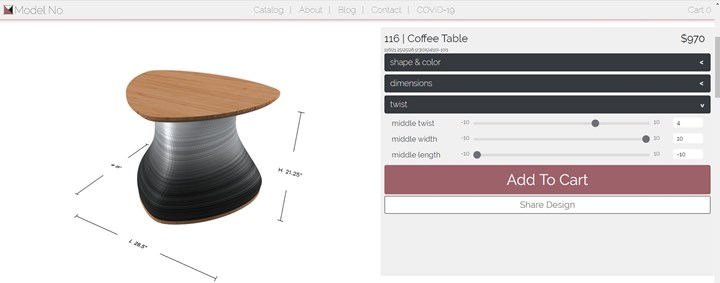
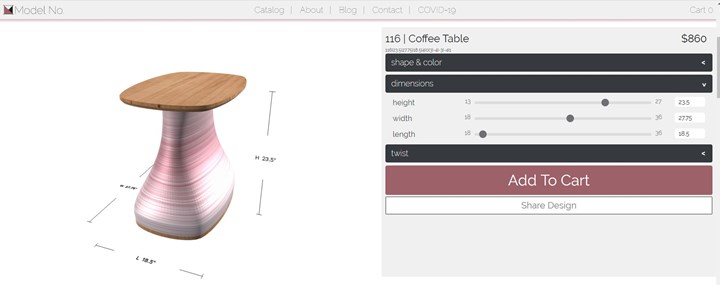
The parametric controls built into each design allow customers to manipulate the same base product into many different variations, while ensuring that the final piece will be both printable and functional.
“The coffee table that you see on the website is a scripted piece that has parameters built into it,” Northrup says. Customers can adjust within those parameters, which have been set to ensure both the manufacturability of the design and its performance in use. These intrinsic requirements make some products more malleable than others.
“The table bases are kind of a cylinder that you can morph and twist and push and elongate in many different ways,” she explains. Many variations are possible while still allowing the table to be manufacturable and functional. Meanwhile a piece like a chaise lounge offers fewer customizations. There’s also the issue of customer comfort with this method of ordering — Model No. strives to provide the right options, in the right quantity, so that customers feel empowered rather than overwhelmed.
Custom 3D Printers to Build Custom Products
Once the furniture is designed and ordered, Model No.’s hardware capabilities come into play. The hardwood components of its furniture are machined onsite using two large routers (machines that were recently put to a different use during the coronavirus pandemic: cutting plastic for aerosol boxes and face shields). Meanwhile, its 3D printers are extruding PLA to build the rest. Model No. has about a dozen 3D printers, ranging from small prototyping machines to the large printers that build table bases and chaise lounges. But like its approach to software, Model No. was not content with an off-the-shelf product; instead, its largest production 3D printers have been custom-built to this task.
The founders tested some existing printers in the beginning, but none of the options at their price point quite hit the mark. That mark being: a build volume of at least 4 by 4 feet; speed at building a part near those max dimensions; and an open materials platform. Rather than purchase, the team decided to build their own to these specifications. The 3D printers they’ve created are gantry-based systems large enough to handle their furniture products. High-feed pellet extruders and a custom motor system deliver precise motion control and the speed required to produce these products quickly.
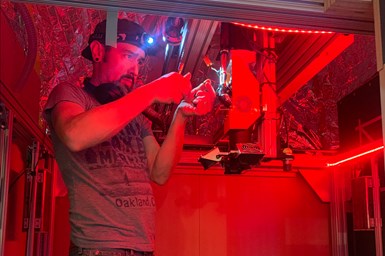
Model No. is continuously updating its custom 3D printers to improve cooling and increase material throughput.
“We can actually push out more material and move faster than the plastic can cool,” Northrup says. “We’re constantly upgrading with various systems to make the cooling happen faster.”
“We’re not a 3D printing company,” McGrew points out, emphasizing that Model No. is first and foremost about furniture. The company has no plans to sell these printers, nor is it ruling out the use of other digital manufacturing technologies as the business scales. But its commitment to developing its own 3D printing technology underscores the fact that for Model No., the manufacturing process cannot be divorced from the product design. 3D printing is the best production method for its custom furniture right now, “but the product design has to harmonize with that,” McGrew says. “Certain shapes can be printed very effectively and quickly; other shapes are not able to print so effectively.”
So far, all of Model No.’s furniture pieces have been designed to print without needing support structures. This fact helps ensure successful prints and minimize postprocessing work, but it also minimizes waste. “Supports can be really wasteful,” McGrew says. “While we can reclaim that material and reuse it, we still try to avoid it.”
Custom and Sustainable Manufacturing
The aim to avoid support structures and the waste they represent points to another fundamental goal for Model No.: sustainable manufacturing. Conventional furniture manufacturing is linear; materials are made into products, stored in inventory, purchased, and eventually discarded. Model No. takes a more circular approach. Both its products and business model have been designed to conserve resources and reduce waste.
The materials that the company uses come from renewable, plant-based sources. Its tabletops are made from locally sourced and FSC-certified hardwoods; all are domestic species selected for their durability as well as aesthetics. The 3D printed portions of its furniture are built from PLA made from agricultural food waste such as sugarcane, corn and soybean starches. As the company’s offerings expand into outdoor furniture and more, it will grow this sustainable material portfolio as needed. Future additions could include materials like wood-fiber reinforced polymer for better durability.
In converting these materials into a bespoke product, Model No. estimates that its carbon footprint is just one-third that of a conventional furniture manufacturer. Its process generates little in the form of scrap thanks to 3D printing and careful product design. Manufacturing happens on demand, so the company has no need to store inventory or to make more furniture than has been ordered. And when a customer is finished with a Model No. product, he/she can return it to the company to be recycled back into feedstock.
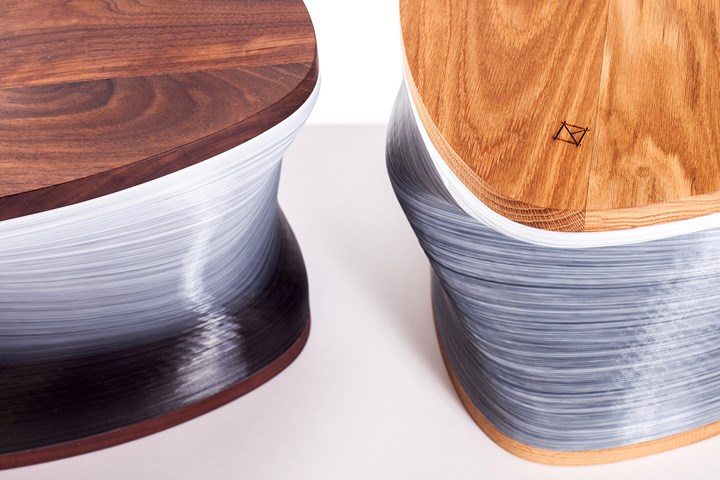
Sustainable manufacturing at Model No. means making just what is needed, from sustainable materials like hardwood and plant-based PLA, with a plan to recapture those resources at the end of the product’s life.
For hardwoods, this means composting back into organic matter that can be used to grow more trees, but for resins, the process is a bit more direct. The plant-based PLA material Model No. uses can be ground up and pelletized into material for new prints — an option that isn’t possible for all 3D printing materials. “There are a lot of petroleum-based plastics that you can ‘recycle’ into something else, but you can’t actually recycle them back into what they were before,” McGrew says. “With this material, we can.” But recycled PLA re-entering Model No.’s sustainable manufacturing process is not just comparable to virgin material; its properties may actually be improved by the recycling process.
“The interesting thing is that the recycled PLA resin we’ve tested is actually slightly stronger than the virgin resin,” McGrew says. “The working theory is that the polymer chains get shortened by the recycling process, and because they are shorter they are more likely to cross-link from layer to layer. The crosslinking also changes the modulus of elasticity so that the plastic is less brittle. You actually wind up with something better as a result of recycling.”
Model No. has already printed some full-scale furniture samples using 100% recycled resin. PLA will eventually break down after five or six reuses like this, so future products made with recycled material will also include some virgin stock. Eventually, the company plans to launch a line that is made from at least 50% recycled resin, giving new life to its old products.
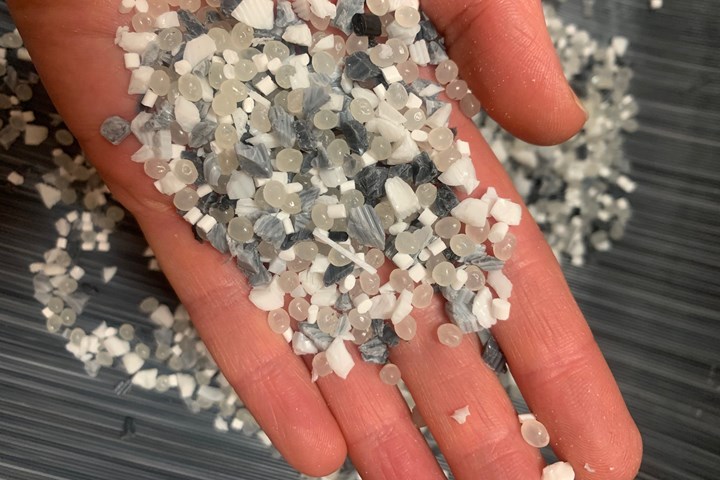
Recapturing old product and recycling it into new filament will likely mean mixing the PLA with virgin material to maintain the needed strength and quality of the polymer.
This plan for recapturing used product might give the impression that Model No. furniture is designed to be short-lived and disposable, but in fact it’s just the opposite. The furniture is intended to be long-lasting, in terms of both durability and specificity. A piece of furniture manufactured to fill a particular niche has a longer potential lifespan than a mass-produced one that forces the consumer to compromise. And when every purchase is designed to be exactly what the buyer needs, Model No. can focus on producing just the unique “model numbers” that have been ordered, no more and no less.
“We want to make stuff that people really love,” McGrew says. Getting the design just right for the end user is about more than aesthetics; it’s the first step in achieving both longer-lasting products and more sustainable manufacturing.
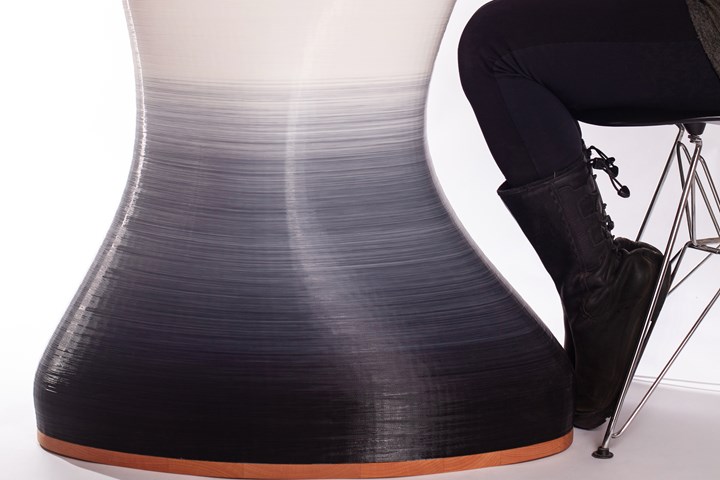
A product that has been custom-made to the person, space and aesthetic required can have a longer lifespan than a standard mass produced item that forces the user to compromise.
Related Content
Video: Orbit X Pro Football Helmet Uses 3D Printed Lattices
The lightweight helmet from Xenith will be used by NFL and collegiate football players beginning in fall 2024.
Read More3D Printing Enables a Larger "Sweet Spot" Relative to This Golf Club's Size: The Cool Parts Show #77
Cobra Puma Golf's Limit3D iron uses 3D printed stainless lattices to remove weight from the interior so that it can be reintroduced with tungsten inserts that lower the center of gravity. The combination offers a smaller, sleeker club head with the forgiveness of a larger one.
Read MoreWhy Customization at Mass-Market Scale Is Finally Possible With 3D Printing
Printer speed and materials coupled with scanning technologies are contributing to more affordable and accessible 3D printed, personalized goods.
Read MoreSustainable Furniture Company Model No. Maintains Product Focus with Switch from DIY to Industrial 3D Printers
The startup founded in 2018 has matured in its product offerings as well as its manufacturing equipment, moving from homegrown 3D printers to industrial large-format machines.
Read MoreRead Next
Why “Recycled” Doesn’t Mean Inferior for 3D Printing Filament
GreenGate3D’s PET-G filament is made from recycled plastic, but that doesn’t diminish its quality. How a recycler found a new business opportunity in 3D printing, and how this success might point the way to a more effective recycling ecosystem.
Read MoreFitz Frames Brings Mass Customization to Eyewear with Affordable 3D Printed Glasses Frames
Glasses don’t need to be ill-fitting and frustrating to buy. Fitz Frames offers a different kind of shopping experience (using augmented reality and 3D measurement) to produce custom glasses with 3D printed frames that are affordable, durable, comfortable and stylish.
Read MoreAdditive Manufacturing Will Aid And Accelerate The Circular Economy
A circular economy links material, design, manufacturing, product and end-of-life in a continuous, sustainable loop. This special report illustrates the roles for 3D printing every step of the way.
Read More
.jpg;width=70;height=70;mode=crop)
